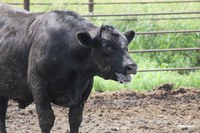N.D. Drought Prompting Calf Health Questions
(Click the image below to view a high-resolution image that can be downloaded)
North Dakota’s drought is raising questions from livestock producers about health issues in calves.
Gerald Stokka, North Dakota State University Extension Service veterinarian and livestock stewardship specialist, says one of those questions is related to weaning calves early: If producers are planning to wean next month, should they give preweaning vaccinations now?
“First, it is important to remember that vaccinations are simply part of a total management approach to help reduce the risk of a specific infectious disease causing illness or death in cattle,” Stokka says. “The risk in this case is respiratory disease (pneumonia), with clinical symptoms and signs ranging from depression, separation from the herd, droopy ears and rapid respiration to high rectal temperature (higher than 104 F) and even death without timely treatment.”
In herds with calves that received preventive vaccines at turn-out time, producers can booster those vaccines with a second dose.
“Whether to administer the vaccines prior to weaning or at weaning is a decision based on the perceived risk, weather and management,” NDSU Extension beef cattle specialist Carl Dahlen says.
The weather decision is based on heat and humidity, according to Dahlen. When the heat index (combination of heat and humidity) reaches 78, which can occur when the temperature is 88 F and the humidity is 40 percent, cattle can suffer from mild stress. Younger animals experience stress more quickly than adults.
Temperatures above 90 F and high humidity can produce severe heat stress in animals.
“The decision is this: Will I do more harm than good by vaccinating the calves?” Stokka says. “If warm weather and humidity are stressors, the answer is do not vaccinate.
“Vaccinating early in the morning can alleviate some of this heat stress; however, make sure the group size can be processed in three hours or less,” he adds. “In addition, product selection is critical here. Use only those vaccines that are absolutely necessary to prevent respiratory disease and keep the use of bacterial vaccines, especially those containing gram negative components, to not more than two.”
The decision applies to preweaning and weaning vaccinations. In herds that did not receive preventive vaccines at turn-out time, ideally, producers should administer vaccines prior to weaning and then provide booster doses at weaning or shortly after weaning, keeping external stressors in mind, the specialists say.
Another question Stokka has received is whether heat and dust contribute to the risk of calves developing pneumonia.
“Heat and dust are visible evidence of environmental stress,” he says. “Heat does increase respiratory rate and dust can overload the cleansing mechanism of the airway.”
He notes that biting flies also can stress cattle. Fly stress causes cattle to crowd together in tight spaces, which increases social stress and the risk of infectious disease transmission. All of these stressors increase the risk of calves developing pneumonia.
Ways to reduce these stressors include fly control, such as spraying the entire herd periodically, and using dust bags, ear tags for fly control and fly larvae inhibitors. Providing shade and allowing the wind to cool the cattle are other ways to reduce heat stress and tight crowding.
For more information, visit the NDSU Extension publication “Dealing With Heat Stress in Beef Cattle Operations” (http://tinyurl.com/beefheatstress).
NDSU Agriculture Communication - July 28, 2017
| Source: | Gerald Stokka, 701-231-5082, gerald.stokka@ndsu.edu |
|---|---|
| Source: | Carl Dahlen, 701-231-5588, carl.dahlen@ndsu.edu |
| Editor: | Ellen Crawford, 701-231-5391, ellen.crawford@ndsu.edu |


